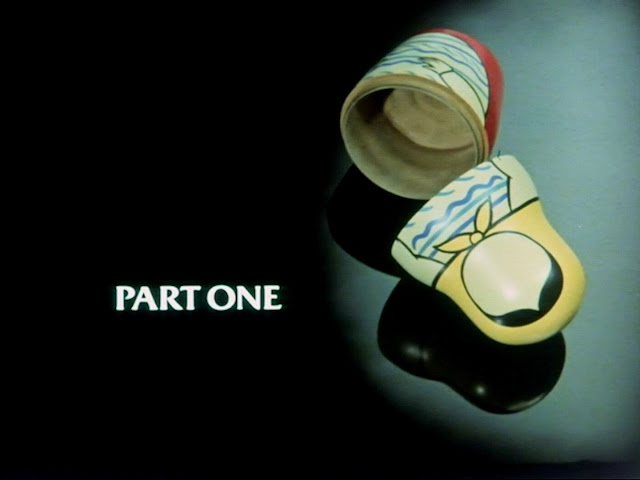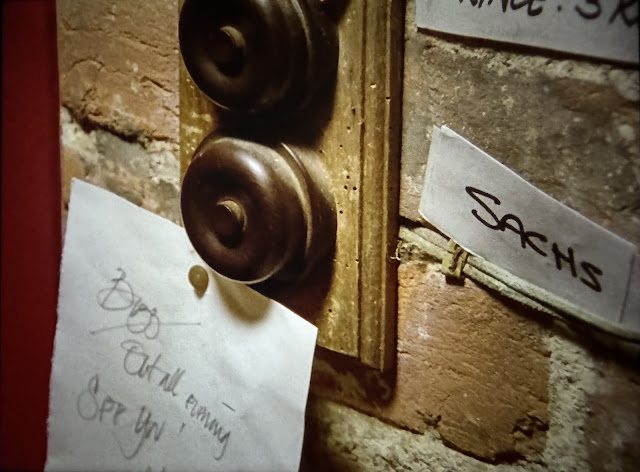POSTED BY CONTROL
Please note this article reveals important information about the plot of Tinker Tailor Soldier Spy.
We recently covered the various
Oxford locations that are featured in
Tinker Tailor Soldier Spy, but there was one additional scene that really belonged in this article. We will look at that final golden shot of Oxford later, but there is only one place to start.

The titles were honoured with an award and a BAFTA nomination:
- Winner of a Design & Art Direction Wood Pencil for Television Drama Titles 1980.
- Nominated for a BAFTA Craft Award for Television Graphic Design 1980.
The BBC Motion Graphics Archive describe the title sequence as follows:
Titles for a serialised John Le Carré spy story which subtly encapsulate the world of spies and counter spies in a nest of Russian dolls. The spy in the story could be one of four suspects as the drama's title suggests. His identity is revealed by a slow meticulous search, admirably symbolised by the slow lifting of each Russian doll, only to reveal another underneath, until we come to the faceless one. The camera moves slowly in as each successive doll is lifted out of shot until only the empty nest of lower halves remains. The faceless doll rolls into shot as the credits roll until all is still. Simple and full of foreboding.
I can still remember the impact of hearing the theme for the first time and seeing that sinister doll move up into shot. It is a dramatic moment that commands the viewers attention. As mentioned above, in the titles the four dolls obviously represent the four suspects but, in the novel le Carré uses the dolls to make a quite different analogy:
Standing at the middle of a secret stage, playing world against world, hero and playwright in one: oh, Bill had loved that, all right.
Smiley shrugged it all aside, distrustful as ever of the standard shapes of human motive. He settled instead for a picture of one of those wooden Russian dolls that open up, revealing one person inside the other, and another inside him. Of all men living, only Karla had seen the last little doll inside Bill Haydon.
There are also
other theories out there about the symbolism of these dolls.
The perfect Christmas present for most of us I'd guess!
Geoffrey Burgon's wonderful opening theme can be found on a comprehensive collection of his television soundtracks titled
Brideshead Revisited: The Television Scores of Geoffrey Burgon. (Potential purchasers should be aware that these are not the original recordings.) The original recording of Nunc Dimittis is on a CD called
Burgon: Choral Music which is sadly no longer available. The good news is that both of these albums are currently available as digital downloads. (You can find a Youtube clip of both original recordings
here.)
On the subject of the haunting Nunc Dimittis, the Independent published this lovely anecdote about its creation as part of Geoffrey Burgon's obituary:
Paul Phoenix, the treble whose voice touched millions, recalled how he was an 11-year-old chorister at St Paul's Catheral when Barry Rose, the Master of the Choristers, asked him to sing for Burgon.
"The plan was this," Phoenix said. "I would sing for Geoffrey, with Barry at the piano, and then he would go away and write the theme tune for 'some BBC TV drama episodes'. The meeting was significant for several reasons: having sung for Geoffrey, he took over at the piano, and started to work on some ideas for the Nunc dimittis, with me singing, at this point without any text. He then asked Barry Rose to play the piano again, and whilst we played and sang together, played his trumpet. To be honest, I didn't think any more about it, until I was invited to the BBC to record the theme to Tinker, Tailor, Soldier, Spy. I was paid £20, incidentally!"
Burgon received the first of his two Ivor Novello Awards for the music but – typically of him, Phoenix feels – not only invited his young singer to the ceremony, but insisted that they receive the award together and that Phoenix say a few words: "I can't think of many people who would have done that".
Nunc Dimittis debuted on the UK singles chart on the 4th of November 1979, peaking at No.56. It was on the chart for four weeks in total.
All of which brings us neatly on to that closing shot of Oxford over which Nunc Dimittis plays.
John Rundle explains: "I think it is very likely that the Graphic Designer/Director for the opening titles, Douglas Burd, also shot the background image for the closing credits. The Graphic Designer usually undertook this task, they being responsible for the actual typeface and style of the credits and, if overlaid on a background, the production of this. In this case it would have been filmed on a 35mm camera, probably an Arriflex IIC."
I had never tried to find the location of this shot before, so we were starting from scratch. There are six architectural elements to match, which I have identified below with '1' being closest to the camera and '6' being the furthest away.
So let's start with the easiest building to identify. The large dome on the right of the screen is
The Radcliffe Camera (5). Behind that is the spire of
The University Church of St Mary the Virgin (6). If we line those two buildings up on streetview and pull back down Catte Street, we can match the architecture at the top of the
Bodleian Library (3). These three buildings are identified in the image below.
So this is the correct line of sight, but obviously at street level. Now we have to find out how far back and how high up Douglas Burd's camera was.
On the left of the screen capture from the series, we can see the upper floors of the corner of a building. If we pull back even further down Catte Street (below) we can match the edge of
Hertford College (1) and the architecture of the turret to the right of it (2). Finally, we can also see the pinnacle on the edge of
All Souls College Library (formerly known as the Codrington Library before 2020) (4).
If you look at the map below, you can see I have highlighted the six numbered architectural elements identified in the screen capture from the end credits. All the elements line up perfectly but once again, the use of a long focal length lens foreshortens the buildings in the background, making them appear much closer to the camera than they actually are. We estimate that the distance from the position of the camera to the spire of St Mary's is about 600 feet/180 metres. (If you click on the map below you will be able to view a higher quality image.)

In our discussions, Chris asked a pertinent question - why was a shot of Oxford chosen to close each episode (and ultimately, the series) - and why this part of Oxford? We know that Oxford was where Haydon and Prideaux met and likely became lovers. Bland and Smiley also went to Oxford and Smiley actually worked in the Bodleian Library for a time. Perhaps this shot of the University buildings bathed in warm, sepia tones is looking back on those halcyon days.
One of Smiley's unanswered questions in the novel is when and how Haydon was recruited by Karla. Smiley tells Guillam that Karla was in Britain in 1936 and 1941 and we know from the letter Haydon sent to his tutor about Prideaux that they were both at Oxford during the 1936-37 academic year. Perhaps Oxford is where the events of Tinker Tailor Soldier Spy were truly set in motion? In any event, it is the perfect note to close on.
My thanks to John Rundle and Chris for their contributions to this article. If you have any inside information you'd be willing to share about the filming of
Tinker Tailor Soldier Spy or
Smiley's People please do not hesitate to get in touch with us at
guinnessissmiley@icloud.com












You guys are absolute life savers, bless you for doing all this research- going to visit the buildings today! :D xx
ReplyDeleteThat’s great to hear - thanks so much. Control
Delete